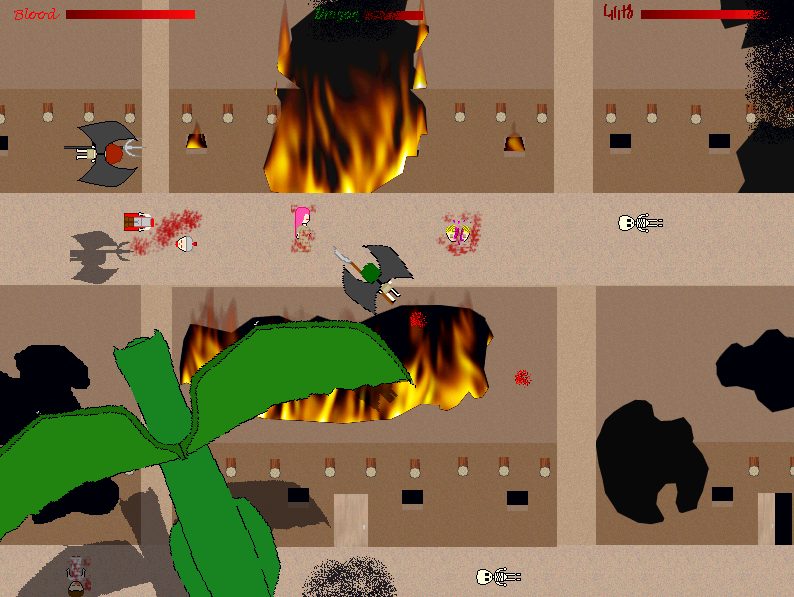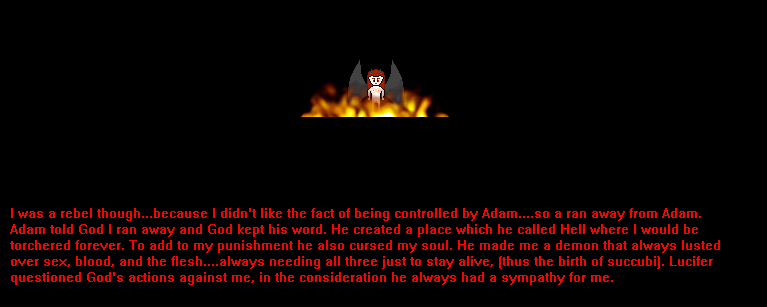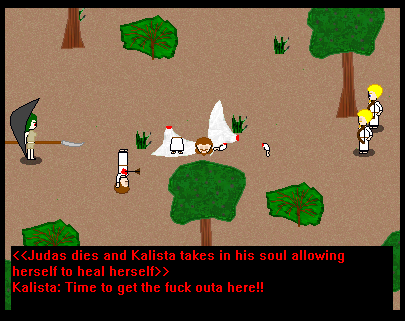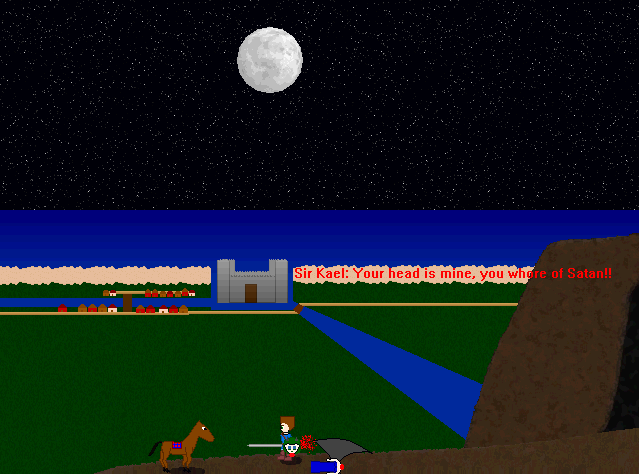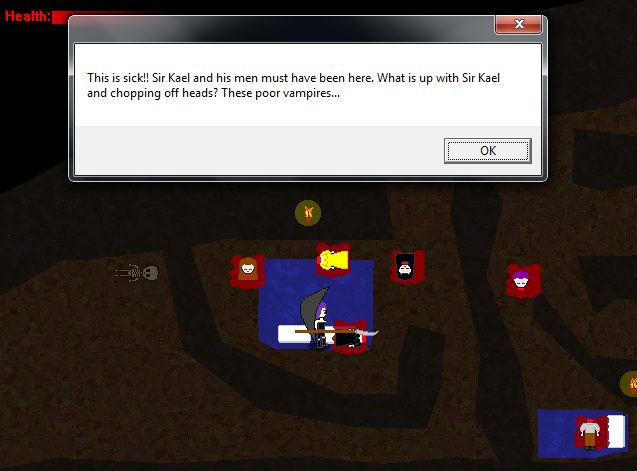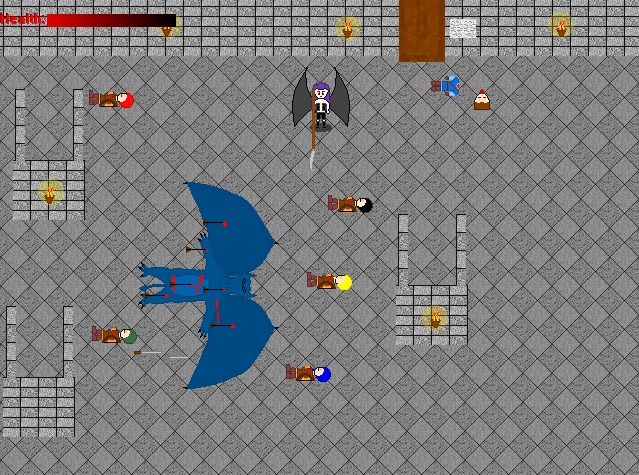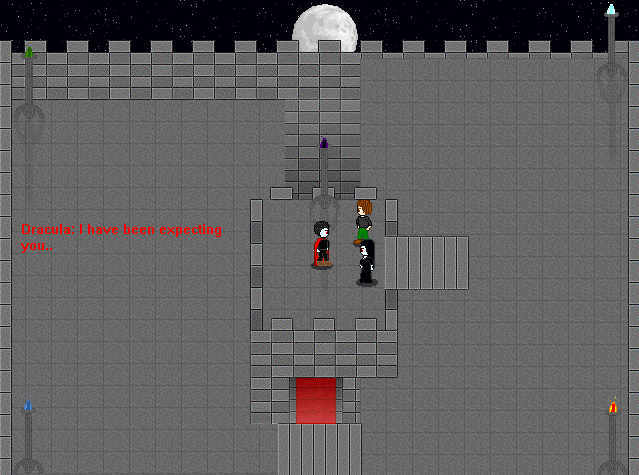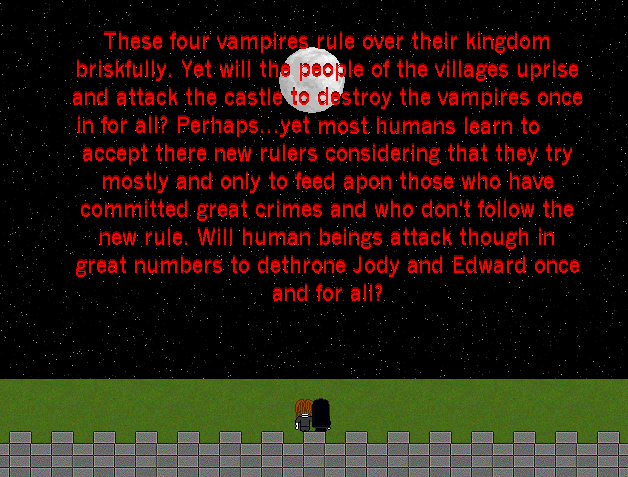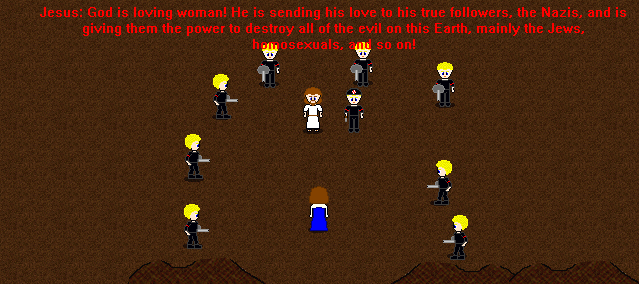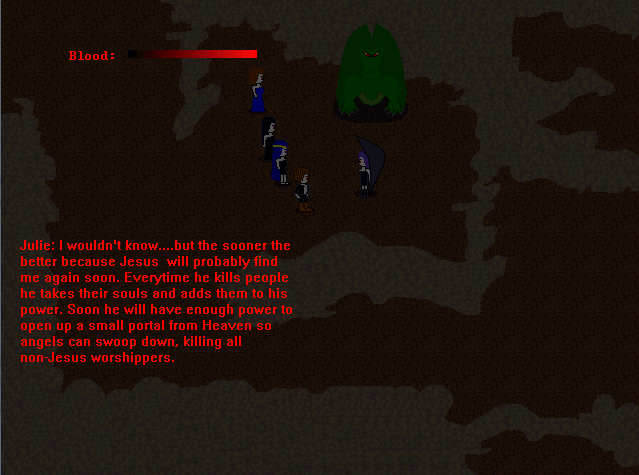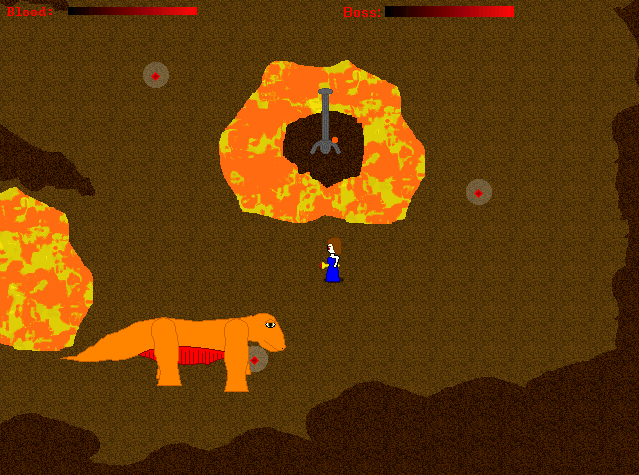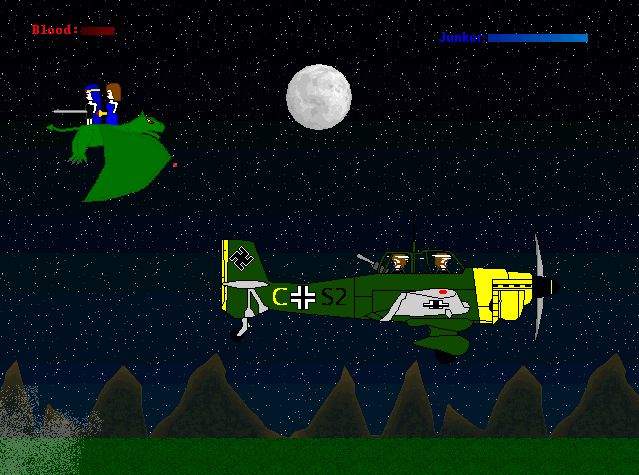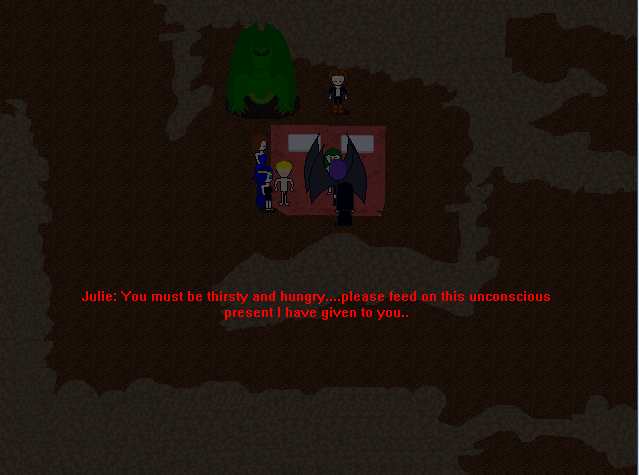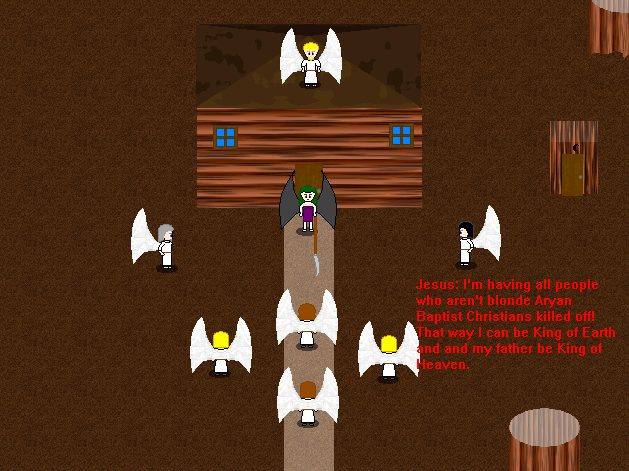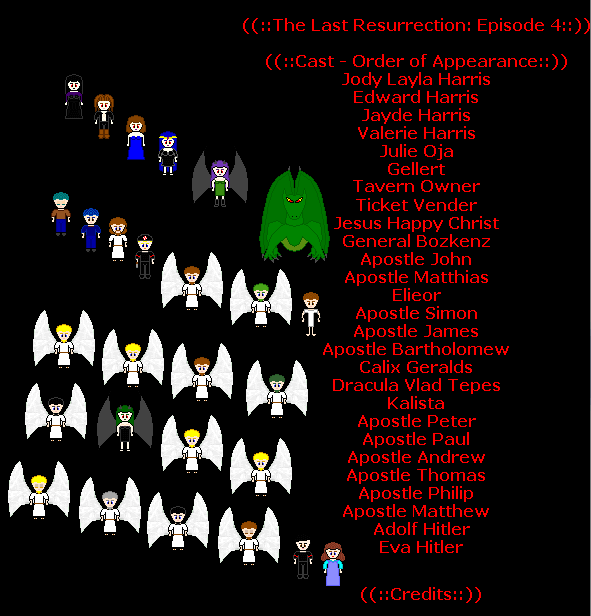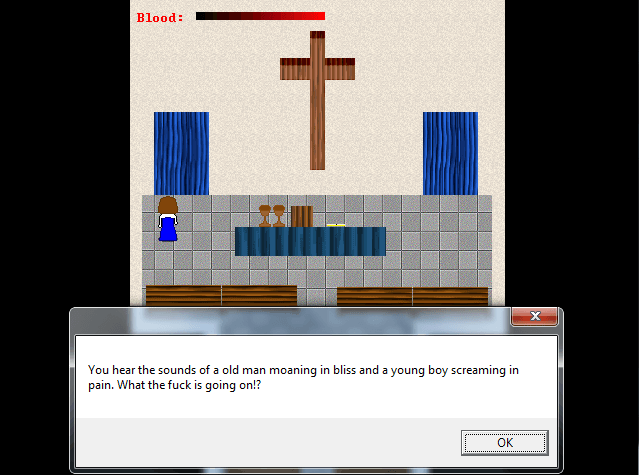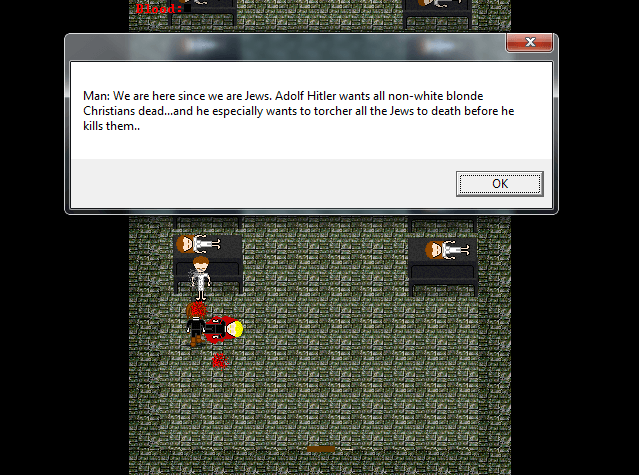Content warning: this article discusses fictional portrayals of rape, incest, necrophilia and Nazi atrocities, along with a whole lot of religious insensitivity.
Jesus Christ was sent to Earth with one mission: to enslave humanity. The witch-hunts, the crusades, and even the Holocaust were all carried out under the personal orders of Jesus himself.
Christ’s plans must be thwarted, and the task falls upon the enemies of God: the likes of Lilith, Lucifer, and Judas Iscariot, not to mention the sundry dragons, vampires, and succubae that have been hunted by Christian warriors over the centuries. Leading the band is the succubus Kalista, daughter of Lilith, who must rise as the Antichrist and save the world from the forces of Jesus.
This is the premise of The Last Resurrection, an independent Windows game created by the Hinph Gaming collective and released piecemeal between 2001 and 2003. Although outwardly a mere Legend of Zelda clone, the game attempted to offer a profound and iconoclastic criticism of organised religion.
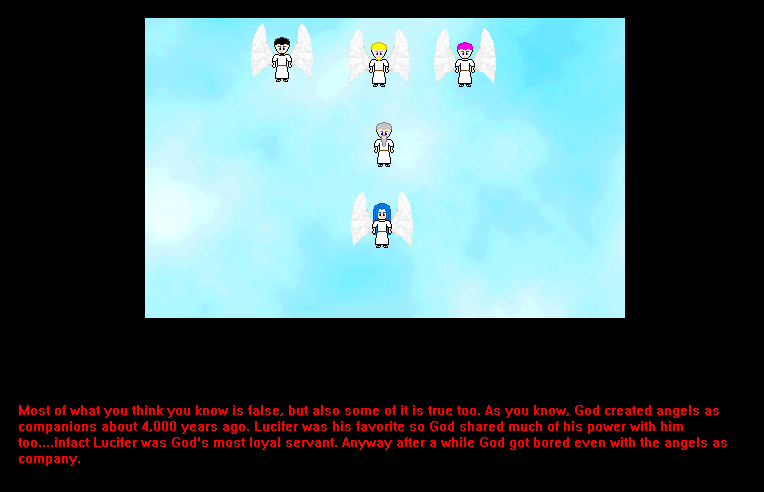
It would be easy to mock the results. Easy, but not entirely fair.
After all, Hinph Gaming consisted of teenage amateurs. Who, as an adolescent geek, did not plot out their own intricate but incoherent sagas of superheroes, or elves, or vampires, or space marines? We may look back on our early creative endeavours with embarrassment; this is why I have avoided mentioning any of Hinph’s members by name. But deep down, I think that most of us harbour a degree of nostalgia for that stage of imaginative development. As one of the most famous juvenile fantasists of all once put it, “it’s a magical world, Hobbes, ol’ buddy…”
I was around 15 or 16 when I came across The Last Resurrection, shortly after it had been released. I had started playing around with homebrewed game development at the time, and paid fairly close attention to the scene. Even at that tender age, I had to roll my eyes at a game in which nineteenth-century Transylvanian aristocrats spoke like valley girls. Yet, more than a decade later, The Last Resurrection remains lodged in my mind.
In part, this is because when I look back at The Last Resurrection, I am instantly transported to my own teenage years. The game is a veritable time capsule of early-twenty-first-century adolescent pop culture, one that holds assorted fragments of anime, Japanese role-playing games and Buffy the Vampire Slayer – often the same fragments that I myself borrowed for my early, inevitably abortive attempts at online fiction.
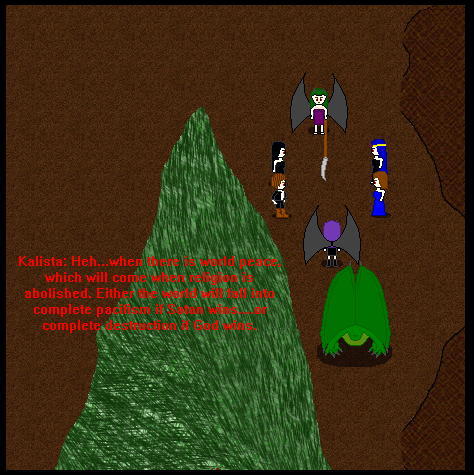
The most memorable aspect of the game is, of course, its attitude towards religion. And this, too, is very much a product of the early 2000s.
 “They kill off women all the time saying they are ‘witches’”
“They kill off women all the time saying they are ‘witches’”
Although Hinph self-identified as an atheist group, The Last Resurrection was clearly influenced by contemporary interest in Neopaganism.
At the time the game was made, Wicca was a blossoming subculture amongst teenagers: Silver Ravenwolf was writing such books as Teen Witch; Buffy’s friend Willow had converted to Wicca, gaining telekinetic powers in the process; and The WB’s Charmed used a similarly fanciful treatment of the belief system. All of these offered a depiction of paganism that was inaccurate, but irresistible to countless youngsters.
Misinformed teenage Wiccans – dubbed “fluffbunnies” by more experienced practitioners – poured onto the burgeoning world of Web 1.0. A key part of their value system was the notion that they were oppressed by Christians, with garbled accounts of early-modern witch hunts widely cited as evidence of this.
At the same time, the fundamentalist Christians who had previously campaigned against rock music and Dungeons & Dragons were now going after Pokémon and Harry Potter. Thanks to the internet, their bizarre screeds reached wider audiences than ever before, and were eagerly mocked and dissected by fans of the pop culture in question.
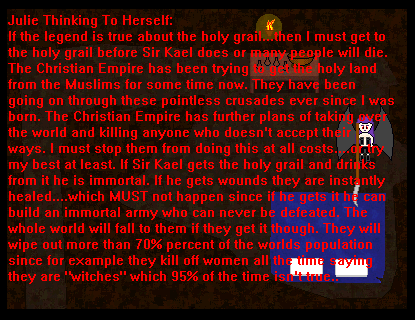
The turn of the millennium also saw the publication of Philip Pullman’s His Dark Materials, a trilogy of fantasy novels in which the Judeo-Christian god is the antagonist. However, The Last Resurrection shows no sign of having been influenced by Pullman’s rather more sophisticated story, which was not well-known in America at the time. More likely inspirations can be found in the field of Japanese role-playing games: Breath of Fire II, Final Fantasy Tactics and Xenogears each feature an evil religion modelled around Christianity, along with a boss fight against God.
With this cultural background, the existence of The Last Resurrection – an homage to Japanese video games that takes a pro-Neopagan, anti-Christian stance – should not come as a great surprise. But as the likes of Xenogears were made in Japan, their sacrilegious interpretations of Christian imagery would not have been particularly controversial amongst the primary audience. The Last Resurrection, by contrast, set out specifically to offend.
“Mother! Jesus has attacked the upper city with a dragon!”
The Last Resurrection is divided into four episodes, a format that recalls the shareware DOS games of the 1990s. The game was made at a time when the Star Wars prequels were hot news, which may explain why the first episode – “The Beginning of the End” – was the last of the four to be released.
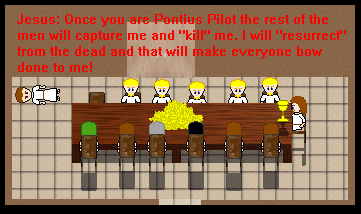 The story begins in Jerusalem, AD 29. Planning to wipe out all non-Christians, Jesus hits on an idea for a propaganda coup: he will fake his own crucifixion with the aid of his Apostles, making it look as though he has miraculously risen from the dead.
The story begins in Jerusalem, AD 29. Planning to wipe out all non-Christians, Jesus hits on an idea for a propaganda coup: he will fake his own crucifixion with the aid of his Apostles, making it look as though he has miraculously risen from the dead.
But Judas is reluctant to go along with this scheme. Our succubus heroine Kalista encounters him as he tries to hang himself, and he reveals all of Jesus’ evil plans to her – including the usage of a mind-controlled dragon to attack Jerusalem.
Kalista runs to her mother Lilith for help (“Mother! Jesus has attacked the upper city with a dragon!”) and we arrive at the game’s first boss fight. After the dragon is slain, Lilith explains to Judas her origin as the first wife of Adam: “Adam first raped me once God made us have different sexes,” she says. “God told me that all of women were always to do what men said or he’d punish us forever.” Lilith broke God’s commands, however, and was turned into the first succubus as punishment.
Rudimentary attempts at feminist revisionism are a recurring theme within the game’s dialogue. “When people go to Heaven then God has more power since he has more soldiers,” explains Lilith at one point. “Luckily he’s a sexist bastard and only lets me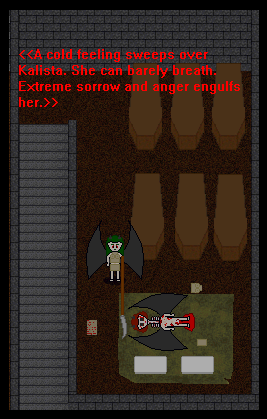 n fight.”
n fight.”
Kalista then goes up against the fireball-chucking apostles Peter and Paul, but this fight turns out to have been no more than a diversion. She returns home to find Lilith raped and murdered: the ex-wife of Adam has had her head and spinal column pulled out, like a Mortal Kombat fatality.
This drives Kalista to visit the Mount of Olives, so that she can confront Jesus and avenge her mother’s death.
“So you came to be my bride?” asks Jesus before the battle. “I bet you have a tight clit like your mother… heh heh. Now with her soul I’m two times as powerful as before and can really take on and wipe out those ignorant Jews.”
Having grown a pair of wings (he’s already outdone Sephiroth!) Jesus flies around blasting fireballs. Succeed in slaying him, and his soul will float out of his body, ready to be absorbed by the succubus protagonist – but then the Apostle Andrew makes off with Jesus’ ghostly form, allowing the nefarious lamb to be raised again in the future.
Judas then sacrifices himself so that Kalista can escape from the Apostles. Hiding in a cave by the Dead Sea, Kalista vows that she will continue to battle the evil forces of Christianity no matter how long it takes.
And so we come to the second episode of the game.
“What is up with Sir Kael and chopping off heads?”
Episode 2, “Race for the Grail,“ takes place during the Middle Ages. Or rather, in a version of the Middle Ages drawn entirely from fantasy fiction. Its setting is the imaginary land of Moremont, home to a princess, a dragon and a knight named Sir Kael – apparently in reference to the villain from the film Willow.
Kalista is now living in Moremont with her protégé, a young succubus called Julie. After Kalista is decapitated by Sir Kael in the opening cutscene, the player takes control of Julie. It turns out that Kael is on a hunt for the Holy Grail, and to bypass the artifact’s magical security system he needs the blood of “the four most superior species on Earth”: humans, succubae, vampires and dragons. The hunt for magic ingredients, a favourite plot device in fantasy games, forms the episode’s backbone.
Hinph has fun turning fantasy conventions on their head. Witness the episode’s unusual spin on the damsel in distress trope: Julie has to hold the local princess (characterised as a spoiled brat) hostage to get information on Sir Kael’s whereabouts.
During the course of the game Julie teams up with a dragon named Gellert, who takes her to the island where the Holy Grail is hidden. If the player defeats Sir Kael and retrieves the Grail, Julie will find herself trapped in the building.
Like all the best dead mentors, however, Kalista is still around in ghost form to lend a helping hand. Her spirit guides Julie to safety, and the episode’s credits assure us of a happy ending (I should mention at this point that all quotations are sic throughout):
Julie and Gellert went to a place far away from Moremont where they lived together feasting on humans as cruelly and sadistically as they wished striking out their vengence…but many adventures are ahead for them..
“My father’s name is Dracula and he is the son of Satan believe it or not”
The third episode of The Last Resurrection, bearing the rather strange title of “The Tragic Princess X,” is set in 19th century Transylvania and focuses upon Dracula and his vampire clan. It is also something of an odd-one-out, as it does not include any of the characters from the previous two episodes and significantly downplays the anti-Christian sentiment found in the rest of the game. Indeed, I rather suspect that it started out as a separate project but was grafted into The Last Resurrection at some point during production.
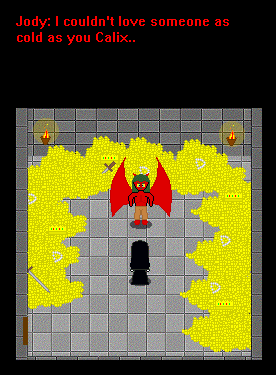 As a character, Dracula’s popularity has seen highs and lows over the decades. He was a significant pop culture figure of the 1960s, when the classic horror films were experiencing a new lease of life on television. At the time The Last Resurrection was made, the Count was enjoying another surge of interest: he turned up in a 2000 episode of Buffy, the 1992 film starring Gary Oldman was still relatively fresh in the public memory, and his regular appearances in Konami’s Castlevania series lent him cred amongst fans of Japanese video games.
As a character, Dracula’s popularity has seen highs and lows over the decades. He was a significant pop culture figure of the 1960s, when the classic horror films were experiencing a new lease of life on television. At the time The Last Resurrection was made, the Count was enjoying another surge of interest: he turned up in a 2000 episode of Buffy, the 1992 film starring Gary Oldman was still relatively fresh in the public memory, and his regular appearances in Konami’s Castlevania series lent him cred amongst fans of Japanese video games.
Episode 3 is The Last Resurrection’s strongest instalment. The mechanics are rough around the edges, as is to be expected from an amateur project, but the episode is a reasonably engaging diversion with a few good gameplay ideas.
The protagonist is Dracula’s daughter, Jody Layla Tepes. Dracula arranges for her to be married to his incubus henchman, Calix; Jody resents this and rebels against her family. As Jody helps a human girl named Jayde to flee from the castle, she is forced to kill Calix in battle. Once the incubus perishes (in a curious piece of animation where his sprite dissolves into its component pixels) Dracula appears and reminds Jody that she remains trapped in the castle. She goes up to the battlements and contemplates suicide:
I guess this is how it all ends… The only way to escape from this… This chaos… This animosity… This despair… If only I could have done more with my life… But there’s nothing for me here.
This scene is accompanied by the music from Final Fantasy VI‘s opera sequence – backyard game developers have often paid little regard to soundtrack clearances.
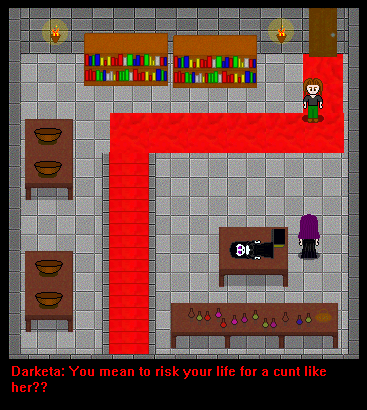 Jody hurls herself to her intended demise, only to land in the arms of a dashing young man: Edward Harris, a vampire hunter who has arrived to slay Dracula. It turns out that Edward is the brother of Jayde, and he recognises Jody as his sister’s saviour.
Jody hurls herself to her intended demise, only to land in the arms of a dashing young man: Edward Harris, a vampire hunter who has arrived to slay Dracula. It turns out that Edward is the brother of Jayde, and he recognises Jody as his sister’s saviour.
Suddenly, a succubus named Lilka Bartley – who was in love with Calix – turns up, and avenges her deceased flame by skewering Edward. Jody must concoct a healing potion to save him; the final ingredient is a succubus’ claw, necessitating a boss battle with Lilka.
Once Edward is healed, he and Jody decide to confront Dracula. But before they can reach him Jody is abducted by Dracula’s mistress, Darketa. The player then takes control of Edward as he rescues her; this is one of the neater ideas in the game, as Jody’s orb-zapping is replaced with Edward’s rather different weapons system involving bullets and holy water.
This part of the game ends with Edward killing Darketa and being reunited with Jody; the player is given the choice of which character to take into the boss fight against Dracula.
Kill Dracula, and the player is rewarded with an ending sequence in which Edward allows Jody to turn him into a vampire. The two then marry, ruling as the new king and queen of the vampire race; they also beget a daughter named Valerie, and turn Edward’s sister Jayde into a vampire so that she can live with them for evermore.
Now, none of this is particularly original or sophisticated. But it works. The plot borrows conventions from Gothic fiction that date back at least as far as the genre’s codification in Horace Walpole’s 1764 novel The Castle of Otranto, and it uses them to good effect within the context of a simple action-adventure game.
“Julie was right! Jesus IS out to kill us all!”
Finally we come to episode 4, “The Last Crusade,” in which the game becomes completely and utterly swamped by anti-Christian filibustering.
It is now 1940; succubus Julie and vampire Gellert meet Jody’s vampire clan as Dracula’s old castle is bombed by Nazis. While part of the Princess Mononoke soundtrack plays in the background, Julie explains all: “Things aren’t what they seem in the world. Followers of Satan are really the good guys, and not the bad ones. The Bible has corrupted people, limiting them to only hear God’s side of the story.”
Julie then reveals where the Nazis fit into this: “Adolf Hitler is a follower of Jesus Christ and secretly promotes God’s Plan in his speeches to the German people.”
After this bombshell, the plot suddenly swerves back into conventional fantasy RPG territory. Julie sends her new allies on a hunt for a set of magic elemental gems which, when brought together, will allow her to resurrect Kalista; all the while they will be pursued by Jesus, who was reawakened when Julie obtained the Holy Grail.
The episode’s first level sees Edward’s sister Jayde searching the Harz Mountains for the fire gem. This setting has a literary association with werewolves, but the game does not utilise it; instead, Jayde has to fight off killer spiders and an orange dinosaur boss that looks like a reject from Super Mario World.
After retrieving the gem, she is confronted by Jesus himself outside the cave entrance.
“I thought you were supposed to be a good guy, like in the Bible,” says Jayde. “HAHAHA! You fool!” replies Jesus. “I only went through that crap to manifest God’s power on Earth. You are all to fall to your knees and worship your creator. But what happens? Other religions come and try to DRAW everyone from what God WANTS. God doesn’t like women who try to do anything a man does. You are already a hell bound demon Jayde…”
Fortunately, Jayde is saved at the last minute by the dragon Gellert. This leads to the most polished boss fight in the entire game, where Gellert must battle a German Junker.
In the next level, Jody’s daughter Valerie breaks into a New York museum to retrieve the air crystal. After cheerfully massacring the security guards, she goes up against two of the Apostles – now resurrected as angels.
And then we come to the level where Edward Harris infiltrates a Nazi death camp.
The crude graphics add to the overall eeriness: the level resembles a child’s drawing of a war zone.
One of the level’s puzzles involves figuring out which of the furnaces contains the key to the next room. Before rifling through human ashes to find it, however, Edward must retrieve a fire extinguisher from the gas chambers next door.
Also included is a laboratory in which a Nazi doctor has been carrying out Mengele-like experiments.
Eventually, we get to the boss fight. Inside the main office of the camp are the apostles James, Simon and Bartholomew. “Julie was right!” exclaims Edward. “Jesus IS out to kill us all!”
A video game set in a Nazi death camp is going to be a tricky thing to pull off at the best of times. Courtesy of Hinph, we have video game set in a Nazi death camp where a vampire has to find the magic elemental crystal of Earth, with no trace of conscious irony to be seen.
Arriving back in Transylvania, Edward tells Jody about his discoveries. Rather peculiarly, the game ties anti-Semitism to the old trope of vampires feeding on villagers:
I can’t believe those Christians!!! It makes sense now!! Dracula and Calix and all of them were followers of Jesus! My whole family were Jews and so were almost all of the people in our village when I was human! The reason they made you kill Jody was to make Christianity malignate by first killing out the Jews first just like Jesus is doing with the Jews in the concentration camps now!
The next level deals with Jody Layla Tepes and her hunt for the water crystal. After the Nazi death camp setting of the previous stage, this level takes us back into fantasy territory by pitting the player against fireball-hurling skeletons.
The boss fight is against Dracula and Calix, who – like the Apostles – have been resurrected as angels.
“How many times must I tell you,” asks Jody. “I am not a sadist like I was and I now give my full allegiance to Satan to stop your evil cause of chaos and destruction.”
“Silly girl!” replies angel-Dracula. “God doesn’t like a woman who speaks her little mind.”
“God is a sexist pig!” retorts Jody. “I curse God’s name!”
With Dracula and Calix defeated and all of the magic crystals gathered, our heroes resurrect Kalista using a modified version of a 1957 Gardnerian Wiccan prayer (“Horned hunter of the night/Work my will by magic rite/By all the powers of land and sea/As I do say, ‘so mote it be.’”)
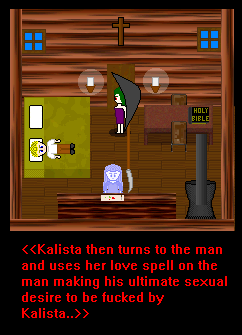 Kalista is resurrected, and immediately begins raping an unconscious man left in the cave by Julie. The morality of this act is not questioned by any of the characters; in fact, a narrative caption tells us that “Everyone except Gellert gets highly sexually arosed by this.” When the man regains consciousness, Kalista kills him by tearing out his throat.
Kalista is resurrected, and immediately begins raping an unconscious man left in the cave by Julie. The morality of this act is not questioned by any of the characters; in fact, a narrative caption tells us that “Everyone except Gellert gets highly sexually arosed by this.” When the man regains consciousness, Kalista kills him by tearing out his throat.
Kalista still needs to regain some strength, so she breaks into a nearby cottage. Finding a couple inside, she freezes the woman solid and uses “love magic” on the man so that he will consent to sex with her. After raping him, she kills the man by draining his blood. “That was short… but pleasurable,” she remarks to herself.
The cottage contains a prominently-displayed Bible and crucifix, seemingly meant as indicators that the couple deserved their fate. The man speaks in the kind of dialect generally associated with “dumb hick” characters, adding a touch of classism to the scene.
Outside the cottage, Kalista encounters Jesus and the remaining Apostles. It is time for the final boss fight, all set to a funky retro-70s soundtrack.
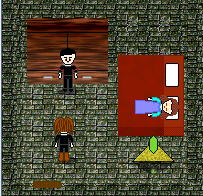 Once Jesus is reduced to a pile of flaming body parts, Kalista reunites with her friends and family to discuss humanity’s future. “The majority of the world has been deceived by God,” says Valerie. “That’s what this whole war with the humans is about. Adolf Hitler is a follower of Jesus just like Dracula was.”
Once Jesus is reduced to a pile of flaming body parts, Kalista reunites with her friends and family to discuss humanity’s future. “The majority of the world has been deceived by God,” says Valerie. “That’s what this whole war with the humans is about. Adolf Hitler is a follower of Jesus just like Dracula was.”
As Kalista’s resurrection caused the magic elemental crystals to be randomly scattered Dragonball-fashion around the world, the main characters spend the end sequence hunting them down and retrieving them to prevent them from falling into the wrong hands. The most interesting part of the ending comes when Edward finds the earth crystal at Hitler’s bunker in 1945, shooting the Fuhrer dead in the process.
“Jesus smiled pervertedly at me”

After the game was completed in 2003, the Hinph website began serialising a prose adaptation of its story. Although left unfinished, the novelisation still weighs in at a fairly hefty 101,000 words, making it slightly longer than To Kill a Mockingbird. This is a quite remarkable achievement: to my mind, the Last Resurrection novel is on a par with the notorious Harry Potter-goes-Goth fanfic My Immortal.
The novel is narrated by Kalista, who – in best fanfic tradition – introduces herself with a physical description (“From my backside diverge to large dragon-like wings”). Rather curiously, all of the dialogue is presented in script format. The overall impression is that the author’s primary experience with the written word comes from caption boxes in video games – and, I hasten to add, the same can be said my own teenage attempts at prose. As with playing the game, I found reading the novel to be an oddly nostalgic experience.
Amongst the new additions to Hinph’s mythos is the revelation that Lilith was not God’s creation, but rather his twin sister. This is established in a somewhat surreal scene where Jesus admits to sneaking around God’s bedroom:
Yeshua: I’ll cut things clean for you Kalista, Lilith is Yahweh’s twin.
Kalista: What!!?! That’s….how is that possible?! And how would you know?!
Yeshua: I found Lilith’s Diary when I was in Yahweh’s room. I heard him mumble something when he was snoozing on his throne. He was having a shout out with Lilith who he periodically called out as “Sister”. I felt suspicious about this and couldn’t help to go snooping in his room. I found this under his bed. […] This is your Mother’s diary.
New members the cast include Joel and Faira, an incubus and fallen angel who both join the fight against God (Yahweh himself, incidentally, is a much more prominent character in the novel than in the game). The fight does not always go well, as this scene indicates:
Joel, now wearing a full suit of armor stood up, with Faira in her simple cotton dress following close behind. Joel ran out of his hospital room and back down the hall, then around the corner. At the corner there was another hall perpendicular to the hall they came from, leading both right and left. Metal clicking footsteps could be heard against the marble tile ahead from the corner of the left side….more soldiers! Then suddenly a angel with long grey hair appeared from the right.
Faira: AGH!! It’s God himself!!
Faira clinged to Joel quickly, afraid for her life. Joel looked to the right seeing God.
God: Drop your weapon Joel! Your surrounded!!
Joel: Fuck!
Attempting to tie up some of the game’s conceptual loose ends, the novelisation clarifies that “Dracula” is not the Bram Stoker character but rather Kalista’s half-brother Farrel:
Young Farrel was a vampire. He had jet black hair unlike his mother who had snow white hair, with a sharp and handsome complexion. He was raised in Transylvania, an area that had a series of religious fundamentalists who were extremely superstitious. They had a belief in a vampire they called Dracula, as you probably heard of from outside of my story. A Dracula had not really existed, before then, but Farrel […] started calling himself Dracula Vlad Tepes after the myth, making the superstition a reality.
The novel also ramps up the game’s sexual elements, with Kalista succubusing as no succubus has ever succubused before. A prime specimen of TMI appears when our anti-heroine, driven mad by the death of her mother, kills a group of villagers and masturbates with their remains: “I moaned loudly with human blood drooling out the side of my mouth” she tells us, before adding that “I fucked myself off with the human leg bone laughing madly.” The Last Resurrection often shows a definite hentai influence, and at this point, Hinph appears to have discovered guro.
Perhaps the most interesting part of the novelisation is a chapter entitled “The Reason for Insanity – The Fall of the Goddess”, where the story plunges headlong into crude feminist spirituality. Opening the chapter with the statement that “I don’t dislike all males, but I do for a vast majority of them,” Kalista goes on to quote verses from the Old Testament in which God states that he is jealous. Making the common mistake that jealousy is the same as envy, Kalista concludes that Yahweh is envious of his female counterpart, Lilith, due to her “intelligence, wisdom, and love for love and peace.” Kalista then tells us that “Lilith is the Goddess, she should be the ruler of things and would do much a better job in Yahweh’s place.”
After this, we get a revisionist take on the Eden story:
Yahweh made Eve off of the idea of Lilith (looks and all), but made sure not to give her intelligence or freewill just as Adam had. So Yahweh sets Adam and Eve off in his Garden of Eden (which used to be in modern day Baghdad, but he destroyed it and turned it into a desert after). They could enjoy all the garden’s delights, but there was one little trick up Yahweh’s sleeve, they couldn’t eat from the Tree of Knowledge. Now guess who shows up to try to fuck with Yahweh to get some hardcore revenge? Lilith!
They call her a serpent, really when it’s Lilith with a few pet snakes on her shoulder. Lilith always had a deep fascination with snakes, and the snake to us has always symbolized the power of the female, intellect, intelligence, and truth. Yahweh saw that Lilith had a fetish for one of his creations, so he put snakes on his scapegoat list. This is why all of the earliest religions (like Paganism and Egyptian religions) have snakes as their centerfolds, who are shown as symbols of the female: power, intellect, and intelligence
“I wanted blood and flesh….Christian blood and flesh”
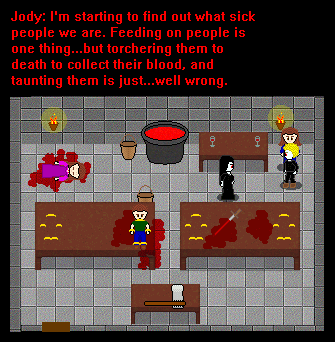 My prime reaction to The Last Resurrection is a feeling of fond amusement; when I look at its glaring flaws, I smile and nod at the memory of making those same mistakes as a teenage author. But it would be remiss of me not to discuss the ugliness of the story’s ideology.
My prime reaction to The Last Resurrection is a feeling of fond amusement; when I look at its glaring flaws, I smile and nod at the memory of making those same mistakes as a teenage author. But it would be remiss of me not to discuss the ugliness of the story’s ideology.
One part of The Last Resurrection that I find troubling is its attitude towards sex. As noted above, the game’s central protagonist rapes and murders two men shortly before the final boss fight. When Jesus takes her to task for killing people, she replies “Yes I do kill every once in a while for food… but you… YOU have killed millions already and you plan to kill nearly everyone on Earth!” So, Kalista’s life of rape and murder is justified by setting her against a colossal straw man.
The novelisation tones down this element of the storyline. It shows the succubae feeding off peasants in a non-fatal manner, with the victims knocked unconscious and returned home. It retains the game’s uncritical portrayal of rape, however, as Kalista and Julie freely violate male peasants (“The man moaned, not caring about the pain with the holes in his neck”).
The novel also contains a lengthy scene in which Kalista is raped by Jesus – “His dick was already erect before my face (roughly 9″), he lifted it and pushed it to my lips” – in which the sexual assault is portrayed in a negative light. It is never made entirely clear how Jesus’ rape of Kalista is worse than the rapes performed by Kalista and Julie. Intentionally or not, the story implies that rape is bad when committed by men, but acceptable when committed by women.
Indeed, the novelisation’s entire understanding of human sexuality appears to come from illicit manga. It makes a point out of positive queer representation, with most of the protagonists being either homosexual or bisexual, but fails to offer anything resembling a healthy sexual relationship. In the first chapter, Kalista has sex with her mother Lilith (“Lilith moved her fingers in and out of me slowly while licking the honey drooling out between my legs”); later, she reveals that she has also had intercourse with her father, Lucifer:
I have even made love to my father a few times. It was a wonderful experience. Most people have a problem with incest….I see nothing wrong. Especially when you are immortal, your Mother or Father could appear to be just a person at your age level.
She has little time for anyone who finds this morally objectionable:
For all the humans that may be reading this, if you have a problem with incest, go fuck yourselves. Seriously, what’s the big deal? Sex is sex as sex is sex. People are just so gosh damn paranoid over it, and when you live as long as me and your parents appear the same age as you it’s no big deal.
This can be excused as the kind of shock-for-shock’s-sake that is naturally appealing to adolescents. But it is worth noting that The Last Resurrection’s Satanic themes avoid the unabashed we’re-the-bad-guys approach favoured by (for example) black metal music, and instead take a weirdly sanctimonious tack: these incestuous, misandry-driven rapists are portrayed as forces of good, nobly saving us from those evil Christians.
Which brings us to how The Last Resurrection portrays religion.
Four specific belief systems are mentioned in the game: Christianity, Judaism, Islam and Wicca. Christianity is demonised, while the other three faiths are portrayed in relatively sympathetic terms as victims of Christian oppression. The novelisation, rather than offering more nuance, retains the simplistic worldview of the game. At one point Kalista tells the reader that genocide is a specifically Christian crime:
Isn’t it weird that all mass genocides in history were caused by Yahweh’s followers? Everything from the crusades, to Native Americans, to witch trials, to Nazi Germany, Yeshua and his men where behind them all.
Kalista appears blissfully unaware of the atrocities committed by Genghis Khan, Scipio Aemilianus, Pol Pot, Josef Stalin, Isamu Cho or Chairman Mao. In contrast to its hostility towards the Christian faith, the novel portrays Judaism as a more open-minded and tolerant belief system:
Yahweh felt [the Jews’] ways were going out of touch and “Liberalizing” with improvements in intelligence, so he grew to dislike them. He sees that Jews aren’t as willingly ignorant since they didn’t believe in Hell anymore so had no excuse for following “Yahweh’s Plan” (Deut. 13). So Yahweh used his powers to create Yeshua (I know you know who that is)….who set out to edit and change the Jewish Torah, and change it to say Hellfire exists and scare people to believing in Yahweh like their new Bible says.
The novel’s foreword states that the story “is written for atheist, Wiccan, Satanist, Luciferinian, Pagan, Jewish, Pantheist, Freethinker, ect. type people,” apparently categorising Judaism as some kind of Neopagan belief system.
The game contains a single brief mention of Islam, in the context of the crusades. The novel goes into more detail, and is quite ambiguous: the only Muslim characters are two sexual predators encountered by Kalista in medieval Jerusalem. But while she criticises Islam’s treatment of women, Kalista regards the religion ultimately as a force for good on the grounds that it is opposed to Christianity (again, I stress that quotations are sic throughout):
You see, over the years of my great sleep, a new religion called Islam was started. During that time the Muslims (the Islam people) grew quite fast and eventually took Jerusalem from the Christians. Now the Christians were striking back in what they called the “Crusades” so they could get Jesus’s land back. […] Muslims actually did a lot of help for us, and still do, I support their causes against, I support their causes againsty don’t know it. I don’t like what they did to women…but they were helping Lucifer unknowingly
In demonising one major religion while consciously giving the others a relatively free pass, The Last Resurrection could fairly be accused of religious hatred.
It bears restating that Hinph’s project has its roots in the “fluffbunny” mindset that was trendy amongst occult-leaning teenagers at the time (for an unsubtle but accurate parody, see this webpage). The fluffbunny scene placed great importance upon the narrative of Pagans being persecuted by Christians, and regarded historical witch-hunts as a communal trauma. The catchphrase “never again the burning times” was popular with young Wiccans of the early 2000s.
In reality, the burning times never went away. While Hinph Gaming was working on The Last Resurrection, Coptic Christians in Egypt were subjected to murders, arson attacks and looting by people who – like our bold heroes Jody, Julie and Kalista – believed Christianity to be an evil faith that had to be stamped out for the good of humanity.
Of course, the simplicity, naivety and crude sensationalism of the game’s anti-Christian message can be contextualised. We should not forget that it was made by a group of Bush-era teenagers; had it been made today, one can readily imagine a few “kill all men” or “die cis scum” slogans being spouted by Kalista and company.
The Last Resurrection is a product of a changing media landscape, in which outsider creators were finding new ways to create platforms – if only small ones – for themselves. It is now easier than ever for people to voice their thoughts, hopes and frustrations; but inevitably, there will be cases where the voice being heard is no more than a series of inarticulate shrieks.


